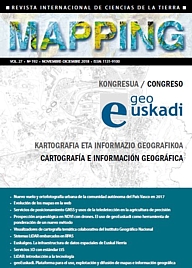Archaeological survey using NDVI with drones.
The use of geoEuskadi as a tool for testing a new method
Keywords:
UAV, multispectral, precision farming, remote sensing, geoEuskadi, dron, survey, archaeology, NDVIAbstract
The objective of this experiment was to test the validity of multispectral
low altitude photography in archaeological surveying.
The experiment involved taking multispectral photographs from
a UAV of ten plots of land through which the Roman road Iter 34 is
thought to have passed.
These photographs were used to create georeferenced orthomosaics
of the zones and to calculate the NDVI index, anticipating that
this index would show differencial growth marks in the crops, inperceptible
by other means, which correspond with the Roman road.
A comparative analysis of the historical photographs in the geoeuskadi
database with the NDVI photographs confirmes that negative
stratigraphic features (ditches, wells, pits...) produce positive readings
in NDVI whereas positive stratigraphic features (walls, surfaces, demolition
deposits) result in negative readings.
The Roman road was seen clearly in NDVI in eight of the ten surveyed
zones, furthermore two ancient settlements were identified in
two of these zones. The experiment can therefore be considered a
success and has demonstrated the validity of the method applied
to archaeological survey.





